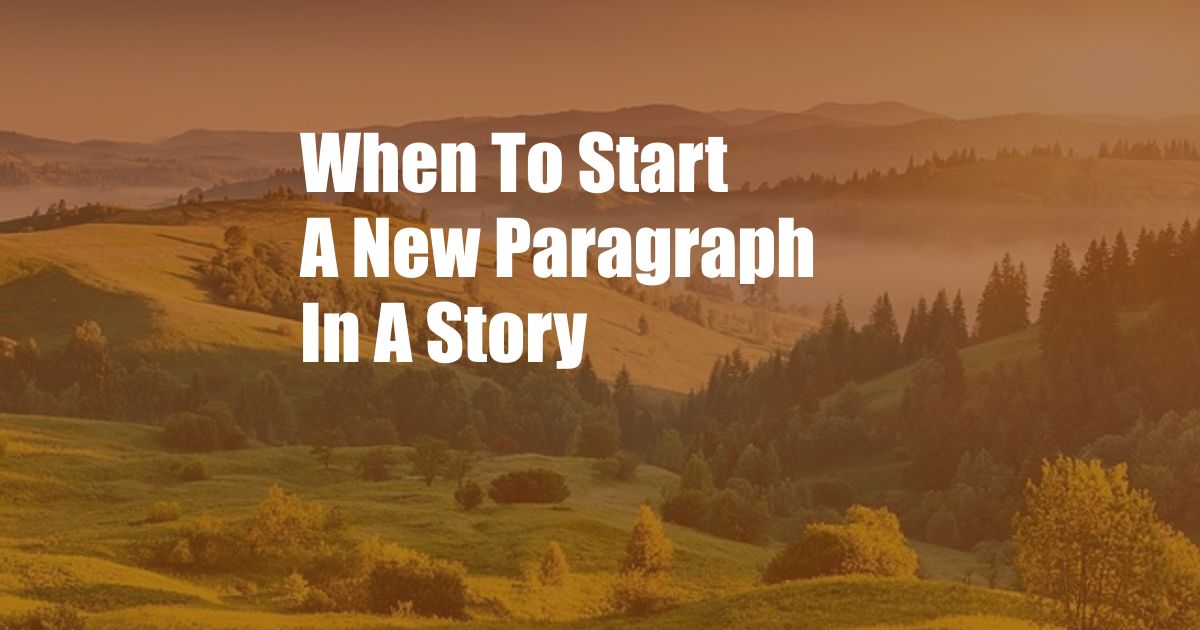
When to Start a New Paragraph in a Story
I remember a time when I was writing a story, and I got stuck on a certain scene. I had written a few paragraphs, but I wasn’t sure if I had covered everything I needed to. I went back and reread what I had written, and I realized that I could break it up into two paragraphs. This made the scene more readable and easier to understand. So when do you know when to start a new paragraph in a story?
There are a few general guidelines you can follow. First, starting a new paragraph when the scene changes or when there is a change in time is a good idea. This helps to keep the story moving and prevents it from becoming cluttered. Second, you should start a new paragraph when you introduce a new character or when there is a change in the point of view. This helps to keep the reader oriented and prevents confusion.
Starting a New Paragraph When the Scene Changes
When the scene changes, it’s a good idea to start a new paragraph. This helps to break up the story and make it more readable. For example, if you’re writing a scene in a living room, and then the scene changes to a bedroom, start a new paragraph. This will help the reader to visualize the change in setting.
Another example is if you’re writing a story about a character who is walking down the street. You could start a new paragraph each time the character passes a new building or landmark. This would help to break up the scene and make it more interesting.
Starting a New Paragraph When There is a Change in Time
When there is a change in time, it’s also a good idea to start a new paragraph. This helps to make the story’s timeline clear and prevents confusion. For example, if you’re writing a story about a character who is remembering a past event, start a new paragraph when the character starts to remember the event.
Another example is if you’re writing a story about a character who is traveling. You could start a new paragraph each time the character arrives in a new location. This would help to break up the journey and make it more interesting.
Starting a New Paragraph When You Introduce a New Character
When you introduce a new character, it’s a good idea to start a new paragraph. This helps to introduce the character to the reader and prevent confusion. For example, if you’re writing a story about a group of friends, start a new paragraph when you introduce each new friend.
Another example is if you’re writing a story about a teacher and her students. You could start a new paragraph for each student.
Starting a New Paragraph When There is a Change in the Point of View
When there is a change in the point of view, you should start a new paragraph. This helps to make the story more readable and prevents confusion.
For example, if you’re writing a story from the first-person point of view, and then you switch to the third-person point of view, start a new paragraph. This will help the reader to understand the change in perspective.
Another example is if you’re writing a story about a group of characters, and you want to switch from one character’s point of view to another. Start a new paragraph when you do this.
Tips from an Expert Author
Here are a few tips from expert author James Scott Bell on when to start a new paragraph:
- Start a new paragraph when the scene changes.
- Start a new paragraph when there is a change in time.
- Start a new paragraph when you introduce a new character.
- Start a new paragraph when there is a change in the point of view.
- Start a new paragraph when you want to emphasize a new idea or thought.
By following these tips, you can make your story more readable and engaging for your readers.
FAQ on Starting New Paragraphs
- Q: How do you know when to start a new paragraph in a story?
- Q: What are some tips from expert authors on when to start a new paragraph?
- Q: Why is it important to start a new paragraph when the scene changes?
A: There are a few general guidelines you can follow, such as starting a new paragraph when the scene changes, when there is a change in time, when you introduce a new character, or when there is a change in the point of view.
A: Expert authors recommend starting a new paragraph when the scene changes, when there is a change in time, when you introduce a new character, when there is a change in the point of view, or when you want to emphasize a new idea or thought.
A: Starting a new paragraph when the scene changes helps to break up the story and make it more readable. It also helps to keep the reader oriented and prevents confusion.
Conclusion
Starting a new paragraph in a story is a simple but effective way to improve the readability and engagement of your story. By following the tips and guidelines outlined in this article, you can make your story more enjoyable for your readers.
Do you have any questions about when to start a new paragraph in a story? Let us know in the comments below!